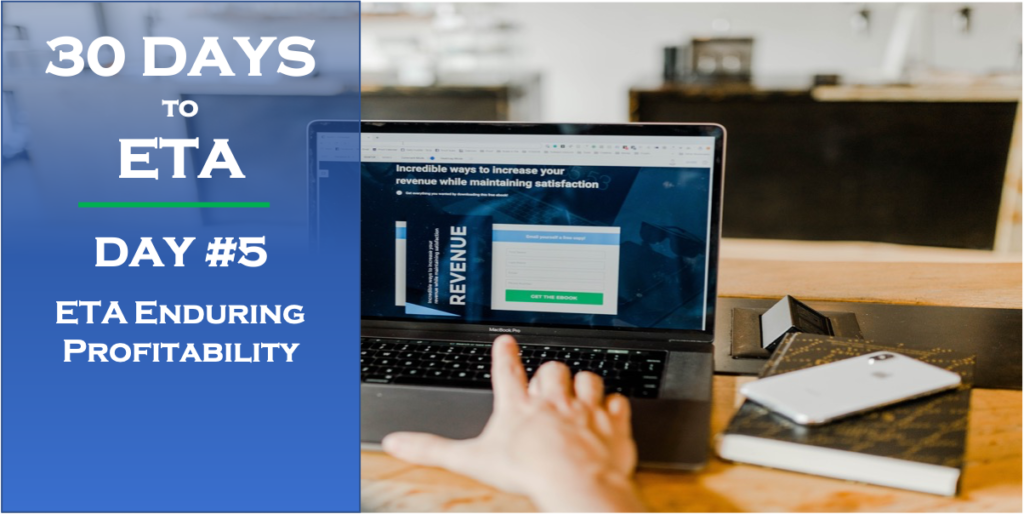If you’re following my 30 Days to ETA series, you know that my goal is to help you find a business to either merge with or acquire. In our last post, we explored how to add value to your company so that when it comes time to sell it, you maximize the sales price as much as possible (You can read the previous post by CLICKING HERE). In this article, we’re going to focus on what it really takes to be an Entrepreneur Through Acquisition, namely you don’t need to do it alone. Instead, you’re going to need to bring a team with you (Your ETA Team). Think of Your ETA Team as a group of specialists you hire to help you in your Mergers & Acquisitions endeavor, and you’ll want the best people on this team! We’ll also look at your organization team (Who will help you in running your business)… Enjoy!
Attend Webinar Workshop: 30 Days to ETA
Your ETA Team
When it comest to 30 Days to ETA, you know the old saying “If you want to go fast, go alone. If you want to go big, bring a team!” is 100% accurate. In my own Entrepreneurship Through Acquisition journey, I know that I thought I could do it all. However, as the Letter of Intent (LOI) was approaching expiration, I realized that there was still way too much left on the “To Do” list than I care to admit. With this in mind, you’ll want to surround yourself with subject matter experts (SME) that can conduct their own portion of the due diligence process.
But who will you want on Your ETA Team? In my experience, you’ll want the following members on Your ETA Team:
- Business Lawyer – Everyone needs a lawyer, especially when it comes to Mergers & Acquisitions. The difference between having a good one and none can be financially devastating. I know of friends who’ve signed LOIs that were intended to be intent-oriented but in reality were purchase agreements — meaning that they were on the hook for purchasing the organization regardless of due diligence findings!
- Forensic Accountants – I’m an accountant by training, and even I recommend bringing in an accountant to do a second review of the books. Why? If the joke about CPAs around tax time is true (How many different answers will five CPAs give you on your tax questions? Six!), then having another set of eyes that can bring you a different perspective will be helpful.
- Valuation Expert – You want a good deal when it comes to structuring your purchase. A valuation expert can provide Your ETA Team with the answers regarding what the valuation is right there/right then.
- Buy-side Broker – I’ve often been on the Sales-side Broker situation, where no matter how “friendly” the broker was during the process, at the end of the day they worked for the seller. With this in mind, they were “selling you” the business. As an Acquisition Entrepreneur know that the broker does not represent you and is not looking out in your best interest. However, a buy-side broker will if you can find/hire one.
Go fast alone, OR go BIG with a group (i.e., the Team!)
Sam Palazzolo, Managing Director @ Tip of the Spear Ventures
Building Your Business Bench
If you’re like me when I first heard the question, “How strong is your bench?”, I thought about the bench full of second-string athletes at a football, baseball, or basketball game. These strong and talented athletes are just waiting for their chance to jump into position at a moment’s notice. Coaches constantly rotate players on and off the field, or on and off the bench, to showcase and preserve the strength of their overall team.
Essentially, I’m talking about that kind of bench, but this article is about small business owners, not football coaches. There aren’t any second-string team members in business. Every player in our business has to be an all-star (A-level player). You must hire the best people you can afford.
Recruiting Your All-Star Business Team
Where do you start? Sure, you see the need to find the “right” people for your business, but how in the world are you going to make that happen? Here is the method we follow at Tip of the Spear Ventures:
- Identify the position, or team member, that will add the most value to the business. As business owners, our personal strengths will shine. At the same time, our weaknesses may be just as glaring to those around us. In order to strengthen the areas in which I’m the weakest, I tend to look for the person who can offset my own skillset. I want to hire someone to fill in the holes I inevitably leave so that my customers see no weaknesses.
- Recruit that team member. Once you know what position you’re attempting to fill, you want to look for that team member. Either hire an agency to conduct the talent search for you, or buck up and do it yourself. If you use an agency, decide beforehand if you want to pay a flat-rate fee for hiring services or if you want to pay on a contingency basis when you hire the agency’s chosen employee. If your small business resources are slim, then you must do your due diligence to check your applicants’ references. You’ll have to review their social media profiles, conduct interviews, discuss job requirements, and agree on pay scales.
- Interview multiple candidates. Choose several people whose qualifications fit your job requirements. Then, let them fulfill the job they’re going to be doing so that you can compare their skill levels for specific tasks. In their working interview, give them time to mess up to see if they can acknowledge their weaknesses and make corrections. I, personally, will always choose an employee with good character over an employee with impressive skills. Skills can be taught and improved upon; character and personality cannot.
- Get a Second (or Third) Opinion. Structure your interviews so that you, as well as no less than one other person (preferably two) interview the same individual. Questions should be similar in nature for compare/contrast amongst the interviewers and should be qualitative — not subjective — in nature.
Once you master this hiring process, whether you go through an agency or hire the individual yourself, you’re going to repeat it until you’ve built out your entire organization. Yes, I said “organization.” You can’t stop after hiring one person. You’re trying to fill your team bench because you want this business to operate autonomously without you.
SUMMARY
You’re not going to win a championship right away, and you certainly are not going to win one all by yourself. Your business won’t sell for millions in the future if you don’t surround yourself initially with Your ETA Team made up of subject matter experts (SMEs) who can help you buy the business right. Thereafter, building your business with the right people who will buy-in to your business plan and know how to implement the best management systems becomes crucial to your success. Your business will grow, and that scalability will increase your company’s sellable value.
Sam Palazzolo




